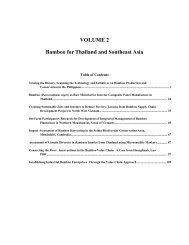WBC-VIII-Vol.4 – Resources – Forestry, Plantations and ... - BambuSC
WBC-VIII-Vol.4 – Resources – Forestry, Plantations and ... - BambuSC
WBC-VIII-Vol.4 – Resources – Forestry, Plantations and ... - BambuSC
You also want an ePaper? Increase the reach of your titles
YUMPU automatically turns print PDFs into web optimized ePapers that Google loves.
(Midmore 2009b) suggest that larger culm diameter species are better suited to timber production only, but such<br />
a conclusion maybe confounded with site effects. Definitive large scale experiments maintained for a number of<br />
decades are still needed to confirm or otherwise these conclusions.<br />
Sustainable management practices for optimal culm quality<br />
From an economic perspective, in traditional forestry, short rotations are preferred over longer rotations, as are<br />
silvicultural practices that favour fast growth, but these may be offset by reductions in physical <strong>and</strong> mechanical<br />
properties of timber <strong>and</strong> lumber grade recovery. Across two species studied in the Philippines, D. asper <strong>and</strong> B.<br />
blumeana (Alipon et al. 2009), physical <strong>and</strong> mechanical properties, such as relative density <strong>and</strong> moisture<br />
content, were not generally significantly affected by the imposition of silvicultural treatments. However,<br />
inherent differences between species were marked. Strength properties were still improving in culms older than<br />
3 or 4 years in B. blumeana, but in D. asper those of 1-2-year-old culms were equivalent to those of 2-3-yearold<br />
culms. D. asper, if it were to be used for construction purposes, could be harvested at close to 2 years of age,<br />
whereas culms of B. blumeana should be at least 3 years old <strong>and</strong> ideally older (Alipon et al. 2009).<br />
For B. blumeana, the treatment that led to the oldest culms at harvest (4<strong>–</strong>5 years of age) overall resulted in the<br />
most suitable culms for construction or housing purposes (but that treatment had inferior shoot production<br />
compared to the well-managed control treatment with harvest of culms at a younger age).<br />
For D. asper, the treatment that gave highest biomass (10-10 SCD) had comparable strength to the untreated<br />
clumps but pulping characteristics were inferior.<br />
Conclusions<br />
Bamboo yields respond to silvicultural practices, both in terms of shoot number <strong>and</strong> yield <strong>and</strong> biomass<br />
production, <strong>and</strong> fine-tuning is necessary for optimal input:output relationships. However, data collected on the<br />
physical <strong>and</strong> mechanical properties of culms from different silvicultural practices are important from a practical<br />
perspective: managing clumps for sustainable shoot or timber productions does not appear to seriously interfere<br />
with the intended use of culms. However, differences between species <strong>and</strong> treatments that affect the ages of<br />
culms at harvest are important considerations when choosing bamboo production practices.<br />
Acknowledgements<br />
I thank all of my co-researchers for their input into the experiments <strong>and</strong> literature reviews that form the basis for<br />
this publication.<br />
<strong>VIII</strong> World Bamboo Congress Proceedings Vol 4-77




